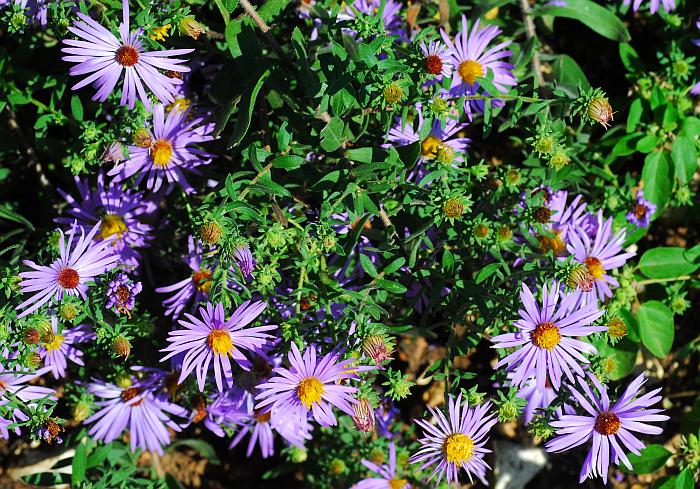Symphyotrichum oblongifolium (Nutt.) G.L. Nesom
Aromatic Aster

Native
CC = 6
CW = 5
MOC = 49
© SRTurner
Symphyotrichum oblongifolium (Nutt.) G.L. NesomAromatic Aster | |
 |
Native CC = 6 CW = 5 MOC = 49 |
© SRTurner |
|
Family - Asteraceae/Astereae Habit - Perennial forb, with a somewhat woody, horizontal rootstock, often also with 1 or more slender and longer-creeping, rhizomatous branches. Stems - Usually several, to 80 cm, commonly with several ascending to spreading branches above the midpoint, sparsely to moderately pubescent with short, spreading hairs, progressively more glandular toward the tip, the branches and apical portion of the main stem usually with dense, stalked glands.
Leaves - Basal and lower stem leaves absent at flowering, sessile or nearly so, the blade 2-6 cm long, 0.5-1.5 cm wide, oblanceolate, tapered at the base, rounded or angled to a usually bluntly pointed tip, the margins entire and hairy, the surfaces usually sparsely pubescent, also usually sparsely glandular. Median and upper stem leaves often relatively numerous, more or less progressively smaller toward the stem tip, sessile, not clasping the stem, the blades 1-10 cm long, narrowly oblong-lanceolate to narrowly lanceolate, narrowed or rounded at the sometimes slightly expanded base, angled or tapered to a bluntly or sharply pointed tip, the margins entire, hairy, the surfaces moderately to densely hairy, those of the upper leaves also with moderate to dense, stalked glands.
Inflorescence - Open panicles, often with numerous heads, sometimes with solitary heads or small clusters at the tips of short to long branches, the heads appearing mostly long-stalked, the bracts few to several, 0.3-0.8 cm long, linear to narrowly oblong.
Heads - 2-3 cm in diameter at flowering. Involucre 5-8 mm long, the bracts in 4-6 subequal to somewhat unequal, overlapping series. Involucral bracts mostly narrowly oblong to narrowly oblong-oblanceolate, all but the inner series angled or short-tapered to the sharply pointed tip, the tip spreading or reflexed, those of the outer series often more or less leaflike, the surfaces and margins with relatively dense, stalked glands.
Florets - Ray florets 15-35 in usually 1 or 2 series, the corollas well developed, 9-15 mm long, purple or rarely pink. Disc florets 30-50, the corollas 4.5-6.0 mm long, the slender portion of the tube usually slightly shorter than the slightly expanded apical portion, the lobes 0.4- 0.7 mm long, 18-25 percent of the total length of the expanded portion. Pappus bristles 4-6 mm long, mostly pale orangish brown to light tan.
Fruits - Achenes 2.0-2.5 mm long, with 7-10 longitudinal ribs, purplish brown to brown, sparsely hairy. Flowering - July - November. Habitat - Limestone glades, bluff escarpments, rocky prairies, open slopes. Also cultivated. Origin - Native to the U.S. Lookalikes - Several other asters. Other info. - This showy aster is common in many parts of Missouri, less so in the northern half of the state. Within the continental U.S. its range includes a broad swath of the Midwest and Plains states. The glandular involucres and usually branched habit are strong clues to the identity. The stems usually bear numerous smallish leaves. Bruised foliage is aromatic, leading to the common name. Photographs taken in Eminence, MO., 10-12-03, and at Tall Grass Prairie National Preserve, KS., 9-23-06 (DETenaglia); also at Shaw Nature Reserve, Franklin County, MO, 10-23-2011, Cuivre River State Park, Lincoln County, MO, 9-29-2012, and Little Lost Creek Conservation Area, Warren County, MO, 10-10-2020 (SRTurner). |